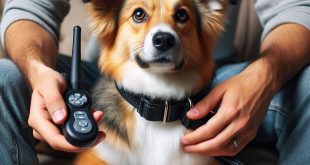Cesar Millan’s Guide to Leash Training Puppies – Walking your new puppy on a leash can be both exciting and challenging. It’s an excellent way to bond with your furry little friend. However, if you don’t instill proper training from the beginning, you may end up with a puppy who pulls, lunges, and jumps at every opportunity. That’s where the world-renowned dog behaviorist Cesar Millan comes in. With his extensive expertise in canine training, he’s provided invaluable insights on how to leash train a puppy properly. From creating a positive association with the leash to teaching basic commands, Cesar Millan’s guide to leash training puppies is a must-read for any new dog owner.
Table of Contents
1. Introduction to Cesar Millan’s Proven Leash Training Techniques
Cesar Millan is a world-renowned dog behaviorist and trainer, famous for his unique and proven methods that have helped countless dogs and their owners. One of the most important aspects of dog training is the leash, which is used to control and guide the dog during walks and other activities.
Cesar Millan’s leash training techniques are based on his understanding of the dog’s psychology and behavior. He believes that dogs have a natural instinct to follow the leader, and the leash is just a tool to help reinforce this behavior. With the right approach, you can use the leash to communicate with your dog, establish trust and respect, and create a positive and healthy relationship.
Some of the key elements of Cesar Millan’s leash training techniques include:
– Establishing yourself as the pack leader: Dogs are pack animals, and they naturally look to their leader for guidance and protection. By establishing yourself as the pack leader, you can gain your dog’s trust and respect, and make it easier to train them.
– Using positive reinforcement: Rather than punishing your dog for bad behavior, Cesar Millan recommends using positive reinforcement to reward good behavior. This can include treats, verbal praise, and physical affection.
– Consistency and repetition: Like any training, leash training requires consistency and repetition to be effective. You should establish clear rules and routines, and stick to them consistently to help your dog understand what is expected of them.
2. Step-by-Step Guide: How to Properly Fit a Leash on Your Puppy
First things first, make sure you have the correct size leash for your puppy. A leash that is too long or too short can be uncomfortable for your furry friend. Measure your dog’s neck circumference and add a few inches for comfort. This will help you choose the appropriate length of the leash.
Once you have your leash, it’s time to fit it properly on your puppy. Follow these steps:
– Step 1: With your puppy standing still, drape the leash over their neck, with the clasp hanging on the side of your choosing.
– Step 2: Reach under their belly and take the leash with your other hand. Bring the clasp up and fasten it to the ring on the leash, creating a loose collar.
– Step 3: Adjust the collar so that it rests comfortably on your pup’s neck. You should be able to fit two fingers between the collar and your puppy’s neck.
– Step 4: Attach the leash to the collar by clipping it to the ring. Make sure the clasp is secured and won’t come loose while you’re walking your furry friend.
Remember, fitting a leash properly on your puppy is important for your pup’s comfort and safety. Follow these simple steps and your puppy will be ready to go for a walk in no time!
3. Patience is Key: Understanding the Psychology Behind Leash Training
Patience is a virtue when it comes to leash training your dog. Understanding the psychology behind leash training is essential if you want to train your dog effectively. Positive reinforcement is the key to creating a happy, well-behaved dog.
One of the most important things to keep in mind when leash training your dog is to be patient. Dogs are creatures of habit, and they need time to adjust to new routines. It’s important to remember that your dog may not be able to immediately grasp the idea of walking on a leash, so don’t give up if your first few attempts aren’t successful.
Another key factor in leash training is understanding your dog’s psychology. Dogs are highly responsive to positive reinforcement, which means that you should reward your dog for good behavior, rather than punishing them for bad behavior. This can be as simple as giving your dog a treat or offering verbal praise when they behave well on the leash. With time, you’ll be able to shape your dog’s behavior in a positive way that will make leash training a breeze.
4. Common Challenges and Troubleshooting Tips in Leash Training Puppies
When it comes to leash training puppies, there can be a number of challenges and hiccups that arise. However, with a bit of patience and some troubleshooting tips, you can work through them and help your puppy become a pro at walking on a leash.
One common challenge is if your puppy pulls on the leash constantly. To combat this behavior, try stopping and re-directing your puppy’s attention whenever they pull. A firm “no” and a quick turn in the opposite direction can help show your puppy that pulling won’t get them where they want to go. Consistency is key, so be sure to do this every time your puppy pulls on the leash.
Another challenge may be if your puppy is scared or nervous about walking on a leash. One way to help alleviate this is to start with shorter walks and gradually increase the length over time. Additionally, try to make the experience as positive as possible by offering treats or praise when your puppy does well. If your puppy is still hesitant, consider using a harness instead of a collar to avoid any discomfort or pressure on their neck. By taking it slow and building up your puppy’s confidence, you can help them feel comfortable walking on a leash in no time.
5. Gradual Progression: Moving from Leash Training to Off-Leash Freedom
For many dog owners, the ultimate goal of training is to have their furry friend experience off-leash freedom. This can be a crucial step in fostering a healthy human-dog relationship. Yet, it’s important to remember that achieving this goal requires a gradual progression of training.
The first step is to ensure that your dog is fully comfortable with leash training. Leash training teaches your dog to follow your commands and ensure their safety in public spaces. It’s essential to work on this foundation before moving onto off-leash training.
Once your dog is comfortable with leash training, you can begin to introduce them to off-leash environments. It’s important to do this gradually, starting with a secured area where your dog won’t run away. You can use verbal commands and positive reinforcement to encourage them to stay within the designated area. As your dog becomes more confident, you can gradually increase the amount of space they have to roam.
Ultimately, moving from leash training to off-leash freedom requires patience, consistency, and positive reinforcement. Every dog is different, and progress will depend on your pet’s unique temperament and learning style. But with dedication and the right approach, you can help your furry friend achieve the ultimate freedom of off-leash training.
If you’re looking for a no-nonsense approach to leash training, Cesar Millan’s guide has it all: safety, comfort and fun for both you and your pup. Soon enough, your pup will be a master of proper leash etiquette—ready to tackle the walkways of the world together, side by side.
 Treat For Dog – Brain Training for Dogs, Dog Training & Obedience Discover Treat For Dog and get your pup on the path to smarter, happier, and healthier living with brain training for dogs.
Treat For Dog – Brain Training for Dogs, Dog Training & Obedience Discover Treat For Dog and get your pup on the path to smarter, happier, and healthier living with brain training for dogs.




